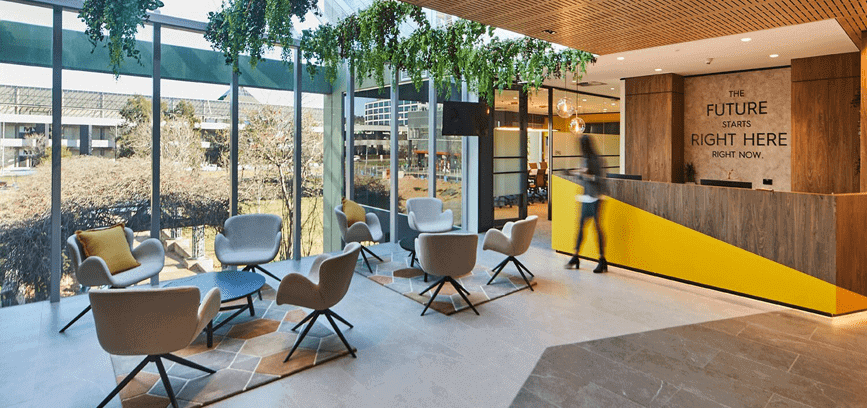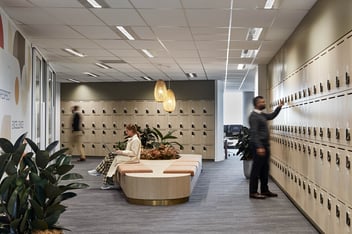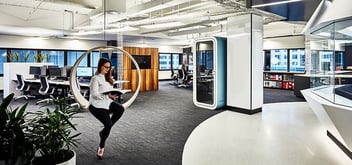With remote working now the norm for many workers in Australia, employers are facing the challenge of how to encourage their employees to return to the office space that they still own or lease. But when everyone has a desk at home, how do you convince people to make the commute?
While there’s much talk about ‘enticing’ people back to the office with incentives and perks, many of these short-term solutions fail to acknowledge that both the way we work and the role of the office have fundamentally changed. A new value proposition for office working is required, one that involves a rethink of the modern workplace and the future of work, complete with increased virtualisation for hybrid workforces.
Many experts in workplace design are calling this The Era of the Destination Workplace. In this article, we’ll explore what this means and how you can start creating a destination workplace today.
What is a destination workplace?
Now that coming into the office is no longer compulsory, most traditional offices hold very little appeal for many employees. If you want to entice your people back to the office, a Destination Workplace is what you’ll need.
The Destination Workplace is a place where employees actually want to be. It’s not simply desks in an office that people are required to be at from 9 to 5, a few days a week. They’re work environments that use concepts of placemaking, that is, paying attention to physical, cultural and social needs to add genuine value to your teams’ lives while enabling their work product. And the widespread adoption of flexible and hybrid working practices has driven a steep incline in popularity.
“We need to reconstruct a workplace to be really valuable to people – to provide functionality that enables us to work in the way we want,” said Cassandra Kirk, Head of Design and Strategy at Axiom Workplaces.
This now also means creating workplaces that offer what cannot be experienced at home – such as spaces that are great for innovation, collaboration, socialisation, and events.
“We’re now coming to the office to do things that are only relevant to being in the office. If we can do an activity at home, then we can choose to do so,” said Cassandra.
By creating a destination workplace that complements the advantages of remote work with the unique benefits of office work, you’ll draw your workforce back to the workplace – not necessarily full-time, but in a regular, purposeful and productive way.
So how do you do this?
4 steps to create a destination workplace:
1. Reallocate spaces
Now that we no longer need large spaces to provide everyone with a desk, business owners can use their square meterage more creatively – or even downsize to save money.
“There’s an opportunity for employers to add varied workspaces that they always wanted. Now they’re no longer limited by their space or financial means and have more flexibility, many can achieve this dream,” said Cassandra.
So if you’ve always wanted a tailored event space with a full kitchen for catering, or break-out collaboration spaces with soft chairs and whiteboards, or even a library for quiet work or inspiration … Now’s the perfect time!
2. Create more engaging spaces
Placemaking has long been associated with creating a sense of community, and new workplace design trends are being heavily influenced by this, according to Peter Black, one of Axiom’s Workplace Strategy Consultants.
“Towns generally have a heart area – a hive of activity – and then quieter spaces that radiate out from that,” explained Peter. “They’re centred around a particular attraction, such as fine food.”
In destination workplaces, this may look like a social centre that has a cafe vibe, or an innovation hub with the best interactive whiteboards and relaxed, comfortable seating.
“It’s not only about functionality,” added Cassandra. “It’s also about creating a wow experience – a magnetic appeal that draws people in.”
The benefits are not just for employees. As people talk about their workplaces and find them enjoyable places to be, this creates an energy that is associated with your business and can attract new talent, benefit your brand and encourage potential leavers to stay.
3. Create more inclusive workplaces
No two employees are the same, but our work environments have typically not catered well for these differences – whether related to geography, working style, caring responsibilities, disability, or illness. However, when you give your workers more choice in where, when, and how they work, you create a more inclusive workplace.
“The ability to structure your day – to work in the way you want – is great. It’s inclusive and opens up roles to more people,” said Peter. “But it does mean that placemaking is a really important part of the office in order to create a purposeful space that people want to be in.”
This is where destination workplaces come in – as a complement to remote work, offering its own unique benefits. By creating an office that people want to be in and that enables different types of productivity, you actually provide your employees (and potential employees) with more options to choose work conditions that suit their daily needs.
So whether it’s dedicated rooms for team collaboration, sound-proofed phone booths for video calls, or breakout spaces for those needing 10 minutes to clear their heads, ensure that your destination workplace can inspire and expand the ways people can work, rather than limiting them.
4. Don’t forget virtualisation
Lastly, don’t forget to cater for the increased virtualisation we’re seeing in work. Even if employees are coming into the office, they will likely still have colleagues who are working remotely. So ensuring that your new destination workplace caters to this with increased spaces for video calls, screens and speakers in all meeting rooms, is critical.
If you’d like to learn more about the new role of the office in the future of work, read the Future of Work: A Progressive Leaders Guide To Staying Ahead.






